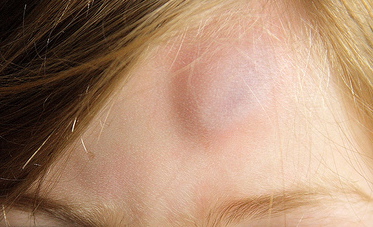Internal Bleeding -
Recognition and First Aid
Internal bleeding occurs when there is a rupture of either an artery, vein or capillaries within the body. Sometimes the bleeding is visible and other times not.
Capillary bleeding is seen under the skin in the form of bruising as in the bump on this girls forehead below. Capillary bleeding/bruising is not usually considered serious but often is painful when touched or knocked.
NOTE: If the injury is to the head it should still be assessed by a doctor.

Internal bleeding from arteries or veins is usually deeper below the skin surface and may result in more severe blood loss. This can occur in the abdominal, chest, digestive system or tissues near broken large bones, such as the thigh bone (femur) and pelvis.
If you need First Aid info NOW click here but if you need to confirm signs and symptoms and other info continue reading.
At first the casualty may not present with any symptoms, although if an organ is bleeding this is often painful. This pain may be overlooked by the assessor or the casualty as they may be distracted with other injuries or issues. Also the injured person may not be able to express pain if they are drowsy, confused or (sounds obvious but) unconscious. So please be aware when helping an injured person that visible signs and symptoms, or even lack of them does not necessarily mean they are in the clear of a more serious injury or condition.
Eventually, bleeding internally usually becomes apparent with possible signs and symptoms such as blood being vomited up or ears leaking fluid (see below for more possibilities).
There are also more vague signs that develop such as generalised pain or tight, rigid abdominal muscles (more mentioned below).
It is important to remember that an injured person may be bleeding internally even if you can't see any blood.
There are 2 classifications
with internal bleeding:-
Visible where the bleeding can be seen. This definition may seem obvious but it is useful to highlight that there is also "unseen" bleeding called Concealed where no direct evidence of bleeding is obvious. Sometimes bleeding is contained within the body such as, within the skull or abdomen area.
Visible - This type of bleeding is easier to identify as evidence is visual and can be seen exiting from:
- Ears - bright, sticky blood or blood mixed with clear fluid
- Lungs - frothy, bright red blood coughed up by the person
- Stomach - coffee colour, bright or dark red vomit
- Bowel or intestines - bright red or dark/tarry blood (as the blood is partially digested)
- Anus or vagina - usually red blood mixed with mucus
- Urinary tract - dark, red coloured or pink tinged urine
- Under the skin (bruising) - dark/purple due to the blood under the skin and not exposed to air

Concealed Bleeding - may not be visible at first but over time symptoms start appearing with possible:
- 'Guarding' or protecting of the abdomen area by the injured person
- Rigid, tight abdominal muscles
- Vague or specific pain, discomfort or tenderness
- Visible swelling of the abdomen
- Nausea and/or vomiting
- Low blood pressure, making the person feel weak and dizzy. If blood pressure is very low, it can lead to loss of consciousness.
- Gradually lapsing into shock some symptoms being:
- Pale, cool, clammy skin
- Extreme thirst
- Rapid, weak pulse
- Rapid, shallow breathing (see Shock page for more info)
Concealed Bleeding is more difficult to recognise therefore if you are unsure it is better to treat the person as if they have internal bleeding.
Internal Bleeding can be life threatening if left untreated. It will not harm the casualty to be managed as if it is happening, so find out what needs to be down for First Aid Management of Internal Bleeding.
If you can see the blood coming from the person's body go to External Bleeding page
So being able to make a good assessment when you have someone bleeding is vital. Having an understanding of bloods appearance and function can make all the difference to the end result. So let's find out more about blood and bleeding...
Forehead photo by Daniel Paquet - Flickr
Black eyes photo by Frederik Beuk